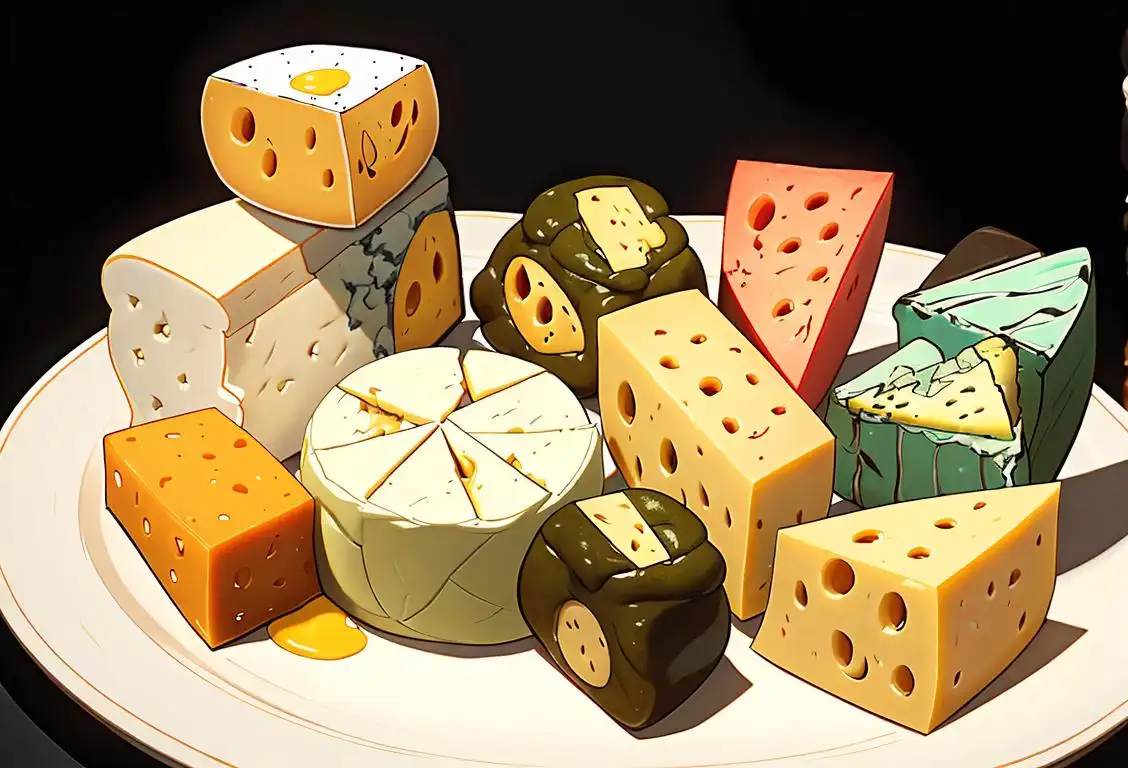National Moldy Cheese Day

Welcome to the cheesy world of National Moldy Cheese Day! Prepare to be delighted, disgusted, and maybe a little bit intrigued as we explore the fascinating history and unique qualities of moldy cheese. Whether you're a cheese connoisseur or just a mild enthusiast, this day is dedicated to celebrating the bold and sometimes controversial flavors that can only be found in those beautiful colonies of mold.
When is Moldy Cheese Day?
It's national moldy cheese day on the 9th October.
A Brief History of Moldy Cheese
Long before the days of refrigeration, our ancestors stumbled upon the magical transformation that occurs when cheese is left to its own devices. Through some accidental experimentation, they learned that certain varieties of cheese could develop a layer of mold on their surface, creating new and unexpected flavors.
While moldy cheese might sound like a culinary nightmare to some, it is actually a highly coveted delicacy in many cultures. Blue cheese, Roquefort, and gorgonzola are just a few examples of beloved cheeses that owe their distinct flavor and texture to the presence of mold.
Over the centuries, different techniques have been developed to purposely introduce mold into cheese production. Whether it's Penicillium roqueforti for blue cheese or Penicillium camemberti for brie, the skilled cheesemakers carefully cultivate these molds to achieve the desired results.
How to Celebrate Moldy Cheese Day
On this special day, embrace the diversity of moldy cheeses and embark on a cheesy adventure. Here are a few ideas to get you started:
- Host a cheese tasting party and challenge your taste buds with a variety of moldy cheeses.
- Experiment with different cheese pairings, from fruity wines to savory charcuterie.
- Visit your local cheese shop and ask the experts for recommendations on the best moldy cheeses to try.
- Get creative in the kitchen and incorporate moldy cheese into your favorite recipes.
- Share your love for moldy cheese on social media using the hashtag #MoldyCheeseDay.
Did You Know?
Did you know that some moldy cheeses are intentionally left to age and develop for months, even years? The longer they age, the more complex and intense their flavors become. So, next time you encounter a chunk of moldy cheese, remember that it's not just a rotting piece of dairy but a culinary masterpiece in the making!
History behind the term 'Moldy Cheese'
1730
The Discovery of Mold on Cheese
In 1730, the term 'moldy cheese' found its origins as a result of a rather accidental discovery. It was during this time that cheese makers first noticed mold growth on their cheese. Initially, this mold was considered a nuisance and a sign of spoilage. However, over time, people realized that certain molds could enhance the flavor and texture of aged cheese.
1857
Louis Pasteur's Research on Microorganisms
In 1857, renowned French scientist Louis Pasteur conducted groundbreaking research on microorganisms and their impact on food preservation. His studies on fermentation and pasteurization helped establish the link between mold and beneficial microbial growth. Pasteur's work revolutionized the understanding of cheese production, leading to the controlled use of mold cultures for specific cheese varieties.
1924
The Roquefort Affair
In 1924, the term 'moldy cheese' gained further significance due to a legal dispute known as the 'Roquefort Affair.' Roquefort, a famous blue cheese made with Penicillium roqueforti mold, faced opposition from American cheese producers. The US government imposed a ban on the import of Roquefort due to concerns about the mold spores. However, this ban was eventually lifted, and Roquefort continued to be enjoyed by cheese enthusiasts.
1967
The Rise of Artisanal Cheese Making
In 1967, the term 'moldy cheese' witnessed a resurgence with the growing popularity of artisanal cheese making. Artisanal cheese makers embraced the use of various molds, such as Penicillium candidum and Geotrichum candidum, to create distinct flavors and textures. This movement revived the appreciation for mold-ripened cheeses worldwide, broadening the range of options available to cheese connoisseurs.
Present Day
Diverse Moldy Cheese Varieties
Today, the term 'moldy cheese' encompasses a vast array of cheese varieties that owe their unique characteristics to deliberate mold cultivation. From the pungent blue cheeses like Stilton, Gorgonzola, and Roquefort to the creamy white-rinded Camembert and Brie, mold plays a crucial role in their aging process. Moldy cheeses continue to captivate palates worldwide and are celebrated for their complex flavors and textures.
Did you know?
Did you know that some moldy cheeses are intentionally left to age and develop for months, even years? The longer they age, the more complex and intense their flavors become. So, next time you encounter a chunk of moldy cheese, remember that it's not just a rotting piece of dairy but a culinary masterpiece in the making!Tagged
food funFirst identified
9th October 2015Most mentioned on
9th October 2015Total mentions
565Other days
Bacon Day
Sweet Tea Day
Medal Of Honor Day
Iced Tea Day
Pumpkin Day
Guac Day
Vodka Day
Foundation Day
Cheese Pizza Day
Pina Colada Day









